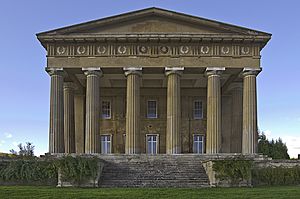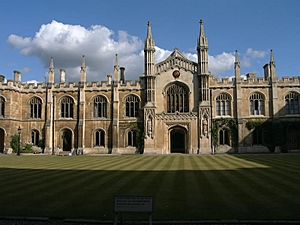William Wilkins (architect) facts for kids
Quick facts for kids
William Wilkins
|
|
|---|---|
| Born | 31 August 1778 Norwich, Norfolk, England
|
| Died | 31 August 1839 (aged 61) Lensfield, Cambridge
|
| Nationality | English |
| Occupation | Architect |
| Buildings | University College, London National Gallery, London |
William Wilkins RA (born August 31, 1778 – died August 31, 1839) was a famous English architect. He also studied ancient cultures and history, making him a classical scholar and archaeologist. Wilkins is best known for designing two very important buildings in London: the National Gallery and University College London. He also created buildings for several colleges at Cambridge University.
Contents
Who Was William Wilkins?
Early Life and Education
William Wilkins was born in Norwich, England. His father, also named William Wilkins, was a successful builder and managed a group of theatres. This early exposure to building and design likely influenced young William.
He went to Norwich School and then earned a scholarship to Gonville and Caius College at Cambridge University. He was a very bright student, graduating as the 6th "wrangler" in 1800. This means he was one of the top math students in his year.
Travels and Discoveries
In 1801, Wilkins received a special scholarship that allowed him to travel. For three years, he visited ancient sites in Greece, Asia Minor (modern-day Turkey), and Magna Graecia in Italy. These travels were very important for his work.
He studied the old buildings and ruins, learning about Classical styles. He even hired an Italian painter, Agostino Aglio, to draw the ancient monuments. These drawings were later used in Wilkins's books about his travels, like The Antiquities of Magna Graecia (1807).
Wilkins's Architectural Style
The Greek Revival Movement
Wilkins became a leading figure in the English Greek Revival movement. This was a popular style in the early 1800s where architects designed new buildings to look like ancient Greek temples. They used features like tall columns and grand entrances.
Wilkins was part of the Society of Dilettanti, a group interested in ancient Greek and Roman art. He published many studies on both Classical (Greek and Roman) and Gothic architecture (a style from the Middle Ages).
First Major Projects
His career as an architect began in 1804. He designed new buildings for Downing College, Cambridge, using his Greek Revival style. Construction started in 1807, but the college was not fully completed to his original plan.
In 1806, Wilkins designed a college for the East India Company near Hertford, which later became Haileybury College. He also worked on The Grange, Northington, in 1809. Here, he changed an old house to look like a Greek temple, adding a large entrance with Doric columns.

Famous London Buildings
The National Gallery
Wilkins played a big part in shaping Trafalgar Square in London. He strongly believed that the new National Gallery should be built on the north side of the square. The government agreed, and Wilkins's design, in a Neoclassical style, was chosen.
The National Gallery (built 1832–1838) was originally shared with the Royal Academy. While it's a famous landmark today, some people at the time criticized its design.
University College London and St George's Hospital
Wilkins designed two other important buildings in London in a similar Classical style:
- University College on Gower Street (designed 1827–1828).
- St George's Hospital (designed 1827–1828), which is now The Lanesborough hotel near Hyde Park Corner.
Other Greek Revival works by Wilkins include the Theatre Royal Bury St Edmunds (1819) and the Yorkshire Museum (1830). He also designed two columns to honor Admiral Nelson: one in Dublin and the Britannia Monument in Great Yarmouth.
Gothic Style and Cambridge Colleges
Wilkins was not limited to the Greek style. He also designed buildings in the Gothic style, which features pointed arches and detailed stonework, similar to medieval churches.
He used the Gothic style for several colleges at Cambridge University:
- In 1823, he won a competition to design new buildings for King's College, Cambridge. These included the main hall, library, and a stone screen.
- In the same year, he started work on the King's court of Trinity College, Cambridge.
- He also designed new buildings, including the chapel, at Corpus Christi College, Cambridge.

Later Life and Legacy
In 1827, Wilkins became the architect for the East India Company. He also entered competitions to design the Duke of York's Column and the new Houses of Parliament. Although he didn't win the Parliament competition, he continued to share his strong opinions on architecture.
He was appointed as a professor of architecture at the Royal Academy in 1837. However, he passed away shortly after, on August 31, 1839, at his home in Cambridge. He was buried in the chapel of Corpus Christi College, a building he helped design.
William Wilkins left behind a lasting legacy of important buildings that shaped the look of London and Cambridge, showcasing his skill in both Classical and Gothic architectural styles.
List of Architectural Works
- Downing College, Cambridge, designed (1805), built (1807–1822).
- Haileybury College, Hertfordshire (1805–1809).
- Lower Assembly Rooms, Bath, Somerset (1808); later demolished.
- Nelson's Pillar, Dublin (1808).
- The Grange, Northington, remodelling (1809).
- Dalmeny House, West Lothian (1814–1819).
- Nelson Column, Great Yarmouth (1815–1817).
- Tregothnan, Cornwall (1815–1818).
- Theatre Royal, Bury St Edmunds (1818).
- New Court, Trinity College, Cambridge (1821–1827).
- New Court, Corpus Christi College, Cambridge (1821–1827).
- Entrance Screen and Great Hall, King's College, Cambridge (1823–1828).
- Former St George's Hospital, London (now The Lanesborough Hotel) (1826–1828).
- University College London (1826–1830).
- Yorkshire Philosophical Society Museum (now Yorkshire Museum) (1827–1830).
- National Gallery, London (1831–1838).
Images for kids



















